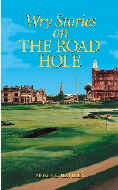Wry Stories on The Road Hole
Weird coincidence. I received my review copy of Wry Stories on the day we returned from a trip to Great Britain that included a day trip to St. Andrews.
We spent a pleasant sunlit breezy hour, watching golfers try their skills at the famous 17th hole.
As I later wrote in my weekly column, I wondered whether I would enjoy this book as much as I enjoyed seeing The Old Course and its Road Hole for myself.
Close, but not quite. Matthew is a Florida attorney whose previous six books chronicled the life and sporting career of Bobby Jones. He says in his Acknowledgments that in February 1999 he came upon the idea of compiling a collection of stories about the 17th hole, while waiting for the snow to melt so he could play the Old Course. Over the next year he put together an interesting, eclectic assortment.
It includes pieces or segments of longer works by long-time journalists such as Charlie Yates and Herbert Warren Wind. Reminiscences by golfing notables such as Francis Ouimet, Henry Cotton, and, of course, Bobby Jones are also well presented.
Using a wealth of resources described in an impressive bibliography, Matthew goes over nearly every inch of the former par 5. Some stories focus on the tee shot, and the variations on the old sheds that tempt long hitters to cut the dogleg. Others delve into the bunkers that frame the entire hole, including “Cheape’s,” “Scholar’s,” and “Progressing,” in addition to the notorious greenside Road bunker.
From my personal observation of a few dozen golfers, every one of these bunkers remains a present-day challenge.
Naturally, many stories concern the triumphs and tragedies that occurred on the Road Hole during The Open Championships. The still-famous “Sands of Nakajima” incident in the 1978 Open is retold here, as is the valiant effort by Tom Watson to hit from the edge of the stone wall in the 1984 Open. The controversial approach by Bobby Jones in the 1930 Amateur, in which some claimed he intentionally hit into the crowd to deflect his approach shot on the hole, eventually led to changes in crowd control procedures at The Open.
One piece, “The Bridge Hole,” will appeal to amateur golf architects. It explains how the Old Course was originally laid out and played clockwise, or as the “left-hand course.” The first hole was near the current 17th green, just over the Swilcan Bridge. The segment then describes how the course played under those conditions, and shows how the various changes in the layout affected play from the original design to the present day.
The photographs and illustrations that dot the book are well done. They help keep the history of the hole in the reader’s mind, and reinforce the sense of tradition that develops from reading the text. The only thing that seems to be missing from the book is some sort of conclusion.
The last piece is a fun segment about the Devil’s Swail in front of the green. The cunning contours redirect errant shots toward the Road Bunker. Though it’s a good bit of writing, it didn’t seem the proper way to finish the book.
The omission may have been intentional. The 17th hole continues to beguile and flummox even the best golfers, notably David Duval in the final round of this year’s Open.
Perhaps Matthew left the book without a real ending because more stories of the Road Hole will surely be forthcoming.
Review date: October 7, 2000


